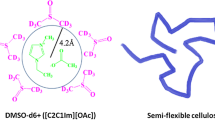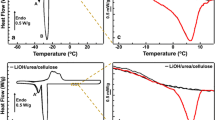Abstract
Polar aprotic solvents are considered to act as cosolvents with ionic liquids (ILs) for cellulose, strengthening the solvating ability of ILs by improving their cellulose solvating kinetics without influencing the solubility of cellulose in ILs. In this work, it was found that dimethylsulfoxide (DMSO) at low concentration improves the cellulose solvating ability of [AMIM][Cl], but weakens it at high concentration. To clarify the mechanism of these dual effects of DMSO on the cellulose solvating ability of [AMIM][Cl], the [AMIM][Cl]/DMSO system was investigated using excess infrared spectroscopy, nuclear magnetic resonance (NMR) T 2 relaxometry, 1H NMR, 35Cl NMR, and dynamic light scattering. The results indicate that the tight association between the cation and anion in the [AMIM][Cl] network is loosened at low DMSO concentration. As a result, mass transport is accelerated due to the enhanced dynamics of [AMIM][Cl], promoting the cellulose solvating kinetics of [AMIM][Cl]. However, ion clusters of [AMIM][Cl] start to form when the molar fraction of DMSO (x DMSO) exceeds 0.5. The hydrogen bonds between cations and anions in the ion clusters become much stronger than in pure [AMIM][Cl], leading to decreased ability of [AMIM][Cl] to form hydrogen bonds with cellulose and thus decreased cellulose solubility in the [AMIM][Cl]/DMSO mixture.






Similar content being viewed by others
References
Andanson JM, Bordes E, Devemy J, Leroux F, Padua AAH, Gomes MFC (2014) Understanding the role of co-solvents in the dissolution of cellulose in ionic liquids. Green Chem 16:2528–2538
Avent AG, Chaloner PA, Day MP, Seddon KR, Welton T (1994) Evidence for hydrogen-bonding in solutions of 1-ethyl-3-methylimidazolium halides, and its implications for room-temperature halogenoaluminate(III) ionic liquids. J Chem Soc Dalton Trans 23:3405–3413
Barber PS et al (2013) Coagulation of chitin and cellulose from 1-ethyl-3-methylimidazolium acetate ionic-liquid solutions using carbon dioxide. Angew Chem Int Ed 52:12350–12353
Berne BJ, Pecora R (2000) Dynamic light scattering: with applications to chemistry, biology, and physics. Dover, New York
Bloembergen N, Morgan LO (1961) Proton relaxation times in paramagnetic solutions effects of electron spin relaxation. J Chem Phys 34:842–850
Bloembergen N, Purcell EM, Pound RV (1948) Relaxation effects in nuclear magnetic resonance absorption. Phys Rev 73:679–712
Borgia GC, Brown RJS, Fantazzini P (1998) Uniform-penalty inversion of multiexponential decay data. J Magn Reson 132:65–77
Butler JP, Reeds JA, Dawson SV (1981) Estimating solutions of 1st kind integral-equations with nonnegative constraints and optimal smoothing. SIAM J Numer Anal 18:381–397
Chen JJ, Kong XQ, Sumida K, Manumpil MA, Long JR, Reimer JA (2013) Ex situ NMR relaxometry of metal-organic frameworks for rapid surface-area screening. Angew Chem Int Ed 52:12043–12046
Chundawat SPS et al (2011) Restructuring the crystalline cellulose hydrogen bond network enhances its depolymerization rate. J Am Chem Soc 133:11163–11174
Dong K, Song YT, Liu XM, Cheng WG, Yao XQ, Zhang SJ (2012) Understanding structures and hydrogen bonds of ionic liquids at the electronic level. J Phys Chem B 116:1007–1017
Fumino K et al (2011) The influence of hydrogen bonding on the physical properties of ionic liquids. Phys Chem Chem Phys 13:14064–14075
Hallett JP, Welton T (2011) Room-temperature ionic liquids: solvents for synthesis and catalysis. 2. Chem Rev 111:3508–3576
Haverhals LM, Nevin LM, Foley MP, Brown EK, De Long HC, Trulove PC (2012) Fluorescence monitoring of ionic liquid-facilitated biopolymer mobilization and reorganization. Chem Commun 48:6417–6419
Huo F, Liu ZP, Wang WC (2013) Cosolvent or antisolvent? A molecular view of the interface between ionic liquids and cellulose upon addition of another molecular solvent. J Phys Chem B 117:11780–11792
Idrissi A, Polok K, Marekha B, De Waele I, Bria M, Gadomski W (2014) Inhomogeneous distribution in methanol/acetone mixture: vibrational and NMR spectroscopy analysis. J Phys Chem B 118:1416–1425
Jiang JC, Lin KH, Li SC, Shih PM, Hung KC, Lin SH, Chang HC (2011) Association structures of ionic liquid/DMSO mixtures studied by high-pressure infrared spectroscopy. J Chem Phys 134:3526485
Jiang ZW et al (2014) Intermolecular interactions and 3D structure in cellulose-NaOH-urea aqueous system. J Phys Chem B 118:10250–10257
Kang HL, Liu RG, Huang Y (2013) Cellulose derivatives and graft copolymers as blocks for functional materials. Polym Int 62:338–344
Kang HL, Liu RG, Huang Y (2015) Graft modification of cellulose: methods, properties and applications. Polymer 70:A1–A16
King AWT, Asikkala J, Mutikainen I, Jarvi P, Kilpelainen I (2011) Distillable acid-base conjugate ionic liquids for cellulose dissolution and processing. Angew Chem Int Ed 50:6301–6305
Koga Y, Sebe F, Minami T, Otake K, Saitow K, Nishikawa K (2009) Spectrum of excess partial molar absorptivity. I. Near infrared spectroscopic study of aqueous acetonitrile and acetone. J Phys Chem B 113:11928–11935
Levitt MH (2001) Spin dynamics: basics of nuclear magnetic resonance. Wiley, New York
Li QZ, Wu GS, Yu ZW (2006) The role of methyl groups in the formation of hydrogen bond in DMSO-methanol mixtures. J Am Chem Soc 128:1438–1439
Li WJ, Zhang ZF, Han BX, Hu SQ, Xie Y, Yang GY (2007) Effect of water and organic solvents on the ionic dissociation of ionic liquids. J Phys Chem B 111:6452–6456
Li QZ, Wang NN, Zhou Q, Sun SQ, Yu ZW (2008) Excess infrared absorption spectroscopy and its applications in the studies of hydrogen bonds in alcohol-containing binary mixtures. Appl Spectrosc 62:166–170
Lin LZ, Yamaguchi H, Suzuki A (2013) Dissolution of cellulose in the mixed solvent of [bmim]Cl-DMAc and its application. RSC Adv 3:14379–14384
Lindman B, Forsén S (1976) Chlorine, Bromine and Iodine NMR. Springer, Berlin
Liu ZJ et al (2015) Effects of additives on dissolution of cellobiose in aqueous solvents. Cellulose 22:1641–1652
Liu ZJ, Zhang C, Liu RG, Zhang WS, Kang HL, Li PP, Huang Y (2016) Dissolution of cellobiose in the aqueous solutions of chloride salts: Hofmeister series consideration. Cellulose. doi:10.1007/s10570-10015-10827-10574
Lu F, Song J, Cheng BW, Ji XJ, Wang LJ (2013) Viscoelasticity and rheology in the regimes from dilute to concentrated in cellulose 1-ethyl-3-methylimidazolium acetate solutions. Cellulose 20:1343–1352
Lu BL, Xu AR, Wang JJ (2014) Cation does matter: how cationic structure affects the dissolution of cellulose in ionic liquids. Green Chem 16:1326–1335
Lu F, Wang LJ, Zhang C, Cheng BW, Liu RG, Huang Y (2015) Influence of temperature on the solution rheology of cellulose in 1-ethyl-3-methylimidazolium chloride/dimethyl sulfoxide. Cellulose 22:3077–3087
Lv YX, Wu J, Zhang JM, Niu YH, Liu CY, He JS, Zhang J (2012) Rheological properties of cellulose/ionic liquid/dimethylsulfoxide (DMSO) solutions. Polymer 53:2524–2531
Meiboom S, Gill D (1958) Modified spin-echo method for measuring nuclear relaxation times. Rev Sci Instrum 29:688–691
Mitchell J, Gladden LF, Chandrasekera TC, Fordham EJ (2014) Low-field permanent magnets for industrial process and quality control. Prog Nucl Magn Reson Spectrosc 76:1–60
Nishiyama Y, Langan P, Chanzy H (2002) Crystal structure and hydrogen-bonding system in cellulose I b from synchrotron X-ray and neutron fiber diffraction. J Am Chem Soc 124:9074–9082
Nishiyama Y, Sugiyama J, Chanzy H, Langan P (2003) Crystal structure and hydrogen bonding system in cellulose I α from synchrotron X-ray and neutron fiber diffraction. J Am Chem Soc 125:14300–14306
Remsing RC, Swatloski RP, Rogers RD, Moyna G (2006) Mechanism of cellulose dissolution in the ionic liquid 1-N-butyl-3-methylimidazolium chloride: a 13C and 35/37Cl NMR relaxation study on model systems. Chem Commun 1271–1273
Rinaldi R (2011) Instantaneous dissolution of cellulose in organic electrolyte solutions. Chem Commun 47:511–513
Sebe F, Nishikawa K, Koga Y (2012) Spectrum of excess partial molar absorptivity. Part II: a near infrared spectroscopic study of aqueous Na-halides. Phys Chem Chem Phys 14:4433–4439
Swatloski RP, Spear SK, Holbrey JD, Rogers RD (2002) Dissolution of cellulose with ionic liquids. J Am Chem Soc 124:4974–4975
Talaty ER, Raja S, Storhaug VJ, Dolle A, Carper WR (2004) Raman and infrared spectra and ab initio calculations of C2-4MIM imidazolium hexafluorophosphate ionic liquids. J Phys Chem B 108:13177–13184
Thar J, Brehm M, Seitsonen AP, Kirchner B (2009) Unexpected hydrogen bond dynamics in imidazolium-based ionic liquids. J Phys Chem B 113:15129–15132
Wilson JD (1992) Statistical approach to the solution of 1st-kind integral-equations arising in the study of materials and their properties. J Mater Sci 27:3911–3924
Zhang H, Wang ZG, Zhang ZN, Wu J, Zhang J, He HS (2007) Regenerated-cellulose/multiwalled-carbon-nanotube composite fibers with enhanced mechanical properties prepared with the ionic liquid 1-allyl-3-methylimidazolium chloride. Adv Mater 19:698–704
Zhang JM, Zhang H, Wu J, Zhang J, He JS, Xiang JF (2010a) NMR spectroscopic studies of cellobiose solvation in EmimAc aimed to understand the dissolution mechanism of cellulose in ionic liquids. Phys Chem Chem Phys 12:1941–1947
Zhang QG, Wang NN, Yu ZW (2010b) The hydrogen bonding interactions between the ionic liquid 1-ethyl-3-methylimidazolium ethyl sulfate and water. J Phys Chem B 114:4747–4754
Zhang C, Liu RG, Xiang JF, Kang HL, Liu ZJ, Huang Y (2014) Dissolution mechanism of cellulose in N, N-dimethylacetamide/lithium chloride: revisiting through molecular interactions. J Phys Chem B 118:9507–9514
Zhao YL, Liu XM, Wang JJ, Zhang SJ (2013) Insight into the cosolvent effect of cellulose dissolution in imidazolium-based ionic liquid systems. J Phys Chem B 117:9042–9049
Zhao YL, Wang JJ, Wang HY, Li ZY, Liu XM, Zhang SJ (2015) Is there any preferential interaction of ions of ionic liquids with DMSO and H2O? A comparative study from MD simulation. J Phys Chem B 119:6686–6695
Zheng YZ, Wang NN, Luo JJ, Zhou Y, Yu ZW (2013) Hydrogen-bonding interactions between [BMIM][BF4] and acetonitrile. Phys Chem Chem Phys 15:18055–18064
Zheng YZ, He HY, Zhou Y, Yu ZW (2014) Hydrogen-bonding interactions between [BMIM][BF4] and dimethyl sulfoxide. J Mol Struct 1069:140–146
Zheng ZP et al (2015) Ionic liquids: not only structurally but also dynamically heterogeneous. Angew Chem Int Ed 54:687–690
Acknowledgments
Financial support from the National Natural Science Foundation of China (21274154, 51473174, and 51373191) is gratefully acknowledged.
Author information
Authors and Affiliations
Corresponding authors
Electronic supplementary material
Below is the link to the electronic supplementary material.
Rights and permissions
About this article
Cite this article
Zhang, C., Kang, H., Li, P. et al. Dual effects of dimethylsulfoxide on cellulose solvating ability of 1-allyl-3-methylimidazolium chloride. Cellulose 23, 1165–1175 (2016). https://doi.org/10.1007/s10570-016-0876-3
Received:
Accepted:
Published:
Issue Date:
DOI: https://doi.org/10.1007/s10570-016-0876-3




